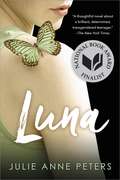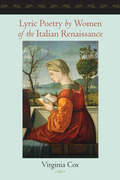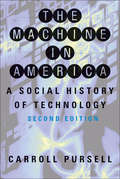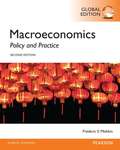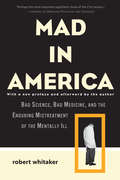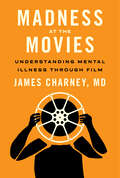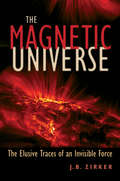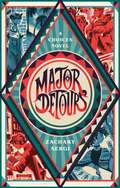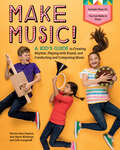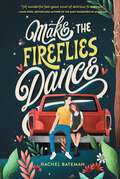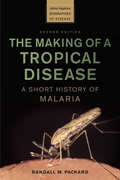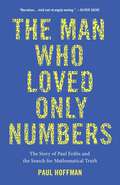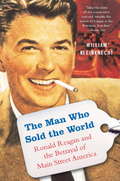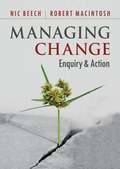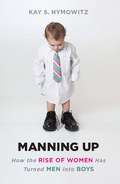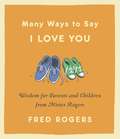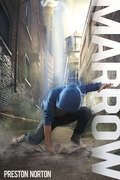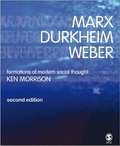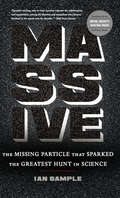- Table View
- List View
Luna (National Book Award Finalist)
by Julie Anne PetersA groundbreaking novel about a transgender teen, selected as a National Book Award Finalist! Regan's brother Liam can't stand the person he is during the day. Like the moon from whom Liam has chosen his female name, his true self, Luna, only reveals herself at night. In the secrecy of his basement bedroom, Liam transforms himself into the beautiful girl he longs to be, with help from his sister's clothes and makeup. Now, everything is about to change: Luna is preparing to emerge from her cocoon. But are Liam's family and friends ready to elcome Luna into their lives? Compelling and provocative, this is an unforgettable novel about a transgender teen's struggle for self-identity and acceptance.
Lyric Poetry by Women of the Italian Renaissance
by Virginia CoxLyric Poetry by Women of the Italian Renaissance is the first modern anthology of verse by Italian women of this period to give a full representation of the richness and diversity of their output. Although familiar authors such as Vittoria Colonna, Gaspara Stampa, and Veronica Gambara are well represented, half of the fifty-four poets featured are unknown even to many specialists. Especially noteworthy is an extensive selection of verse from the period following 1560, which has received little or no critical attention. This later, strikingly experimental, proto-Baroque tradition of verse is reconstructed here for the first time.Virginia Cox creates both a scholarly teaching resource and a collection of poetry accessible to general readers with no previous knowledge of the Italian poetic tradition. Each poem is presented in its original language, accompanied by a translation and commentary. An introduction traces the history of Italian lyric poetry from the fifteenth to the seventeenth century. Cox also provides a guide to meter, rhythm, and rhyme, as well as a glossary of rhetorical terms and a biographical dictionary of authors.Organized thematically, this book offers poems about love, religion, and politics; verse addressed to patrons, friends, family, and places; and polemical and correspondence verse. Four languages are represented: Greek, Latin, literary Tuscan of various levels of standardization, and the stylized rustic dialect of pavan. The volume contains more than 200 poems, of which about a quarter have never before been published in a modern edition and more than a third have not previously been available in English translation."Exhaustive and insightful... This is an amazing book, a major achievement in the field of women's studies."—Renaissance Quarterly, reviewing Women’s Writing in Italy, 1400–1650
Lyric Poetry by Women of the Italian Renaissance
by Virginia CoxLyric Poetry by Women of the Italian Renaissance is the first modern anthology of verse by Italian women of this period to give a full representation of the richness and diversity of their output. Although familiar authors such as Vittoria Colonna, Gaspara Stampa, and Veronica Gambara are well represented, half of the fifty-four poets featured are unknown even to many specialists. Especially noteworthy is an extensive selection of verse from the period following 1560, which has received little or no critical attention. This later, strikingly experimental, proto-Baroque tradition of verse is reconstructed here for the first time.Virginia Cox creates both a scholarly teaching resource and a collection of poetry accessible to general readers with no previous knowledge of the Italian poetic tradition. Each poem is presented in its original language, accompanied by a translation and commentary. An introduction traces the history of Italian lyric poetry from the fifteenth to the seventeenth century. Cox also provides a guide to meter, rhythm, and rhyme, as well as a glossary of rhetorical terms and a biographical dictionary of authors.Organized thematically, this book offers poems about love, religion, and politics; verse addressed to patrons, friends, family, and places; and polemical and correspondence verse. Four languages are represented: Greek, Latin, literary Tuscan of various levels of standardization, and the stylized rustic dialect of pavan. The volume contains more than 200 poems, of which about a quarter have never before been published in a modern edition and more than a third have not previously been available in English translation."Exhaustive and insightful... This is an amazing book, a major achievement in the field of women's studies."—Renaissance Quarterly, reviewing Women’s Writing in Italy, 1400–1650
The Machine in America: A Social History of Technology
by Carroll PursellFrom the medieval farm implements used by the first colonists to the invisible links of the Internet, the history of technology in America is a history of society as well. Arguing that "the tools and processes we use are a part of our lives, not simply instruments of our purpose," historian Carroll Pursell analyzes technology's impact on the lives of women and men, on their work, politics, and social relationships—and how, in turn, people influence technological development.Pursell shows how both the idea of progress and the mechanical means to harness the forces of nature developed and changed as they were brought from the Old World to the New. He describes the ways in which American industrial and agricultural technology began to take on a distinctive shape as it adapted and extended the technical base of the industrial revolution. He discusses the innovation of an American system of manufactures and the mechanization of agriculture; new systems of mining, lumbering, and farming, which helped conquer and define the West; and the technologies that shaped the rise of cities. In the second edition of The Machine in America, Pursell brings this classic history up to date with a revised chapter on war technology and new discussions on information technology, globalization, and the environment.
Macroeconomics: Policy and Practice [2nd edition] (PDF)
by Frederic S. Mishkin2nd edition.For courses in Intermediate Macroeconomics Help students understand macroeconomics in theory as well as practice Macroeconomics: Policy and Practice, Second Edition draws on the rich tapestry of recent economic events to help students understand the policy issues debated by the media and the public at large during these trying times. Building on his expertise in macroeconomic policy making at the Federal Reserve, author Frederic S. Mishkin provides detailed, step-by-step explanations of all models and highlights the techniques used by policy makers in practice. The Second Edition incorporates a wealth of new and updated content, as well as new tools and resources in MyEconLab that bring course material to life. This text provides a better teaching and learning experience-for you and your students. It will help you to: * Personalize learning with MyEconLab: This online homework, tutorial, and assessment program engages students in learning and provides instructors tools to keep students on track. * Enable students to connect theory to practice: An aggregate demand and supply model helps students understand theory, while numerous examples help them understand the applications of theory. * Foster interest via engaging features and updated content: Updates that reflect the latest happenings in the world of economics and student-friendly in-text tools capture student interest. * Teach your course your way: A flexible structure allows instructors to focus on the particular areas of macroeconomics that match their course goals.
Mad in America: Bad Science, Bad Medicine, and the Enduring Mistreatment of the Mentally Ill
by Robert WhitakerSchizophrenics in the United States currently fare worse than patients in the world's poorest countries. In Mad in America, medical journalist Robert Whitaker argues that modern treatments for the severely mentally ill are just old medicine in new bottles, and that we as a society are deeply deluded about their efficacy. The widespread use of lobotomies in the 1920s and 1930s gave way in the 1950s to electroshock and a wave of new drugs. In what is perhaps Whitaker's most damning revelation, Mad in America examines how drug companies in the 1980s and 1990s skewed their studies to prove that new antipsychotic drugs were more effective than the old, while keeping patients in the dark about dangerous side effects.A haunting, deeply compassionate book-now revised with a new introduction-Mad in America raises important questions about our obligations to the mad, the meaning of "insanity,” and what we value most about the human mind.
Mad in America: Bad Science, Bad Medicine, and the Enduring Mistreatment of the Mentally Ill
by Robert WhitakerIn Mad in America, medical journalist Robert Whitaker reveals an astounding truth: Schizophrenics in the United States fare worse than those in poor countries, and quite possibly worse than asylum patients did in the early nineteenth century. Indeed, Whitaker argues, modern treatments for the severely mentally ill are just old medicine in new bottles and we as a society are deluded about their efficacy. Tracing over three centuries of "cures" for madness, Whitaker shows how medical therapies-from "spinning" or "chilling" patients in colonial times to more modern methods of electroshock, lobotomy, and drugs-have been used to silence patients and dull their minds, deepening their suffering and impairing their hope of recovery. Based on exhaustive research culled from old patient medical records, historical accounts, and government documents, this haunting book raises important questions about our obligations to the mad, what it means to be "insane," and what we value most about the human mind.
Madness at the Movies: Understanding Mental Illness through Film
by James CharneyA unique exploration of how mental illness is portrayed in classic and contemporary films.The study of classic and contemporary films can provide a powerful avenue to understand the experience of mental illness. In Madness at the Movies, James Charney, MD, a practicing psychiatrist and long-time cinephile, examines films that delve deeply into characters' inner worlds, and he analyzes moments that help define their particular mental illness. Based on the highly popular course that Charney taught at Yale University and the American University of Rome, Madness at the Movies introduces readers to films that may be new to them and encourages them to view these films in an entirely new way. Through films such as Psycho, Taxi Driver, Through a Glass Darkly, Night of the Hunter, A Woman Under the Influence, Ordinary People, and As Good As It Gets, Charney covers an array of disorders, including psychosis, paranoia, psychopathy, depression, bipolar disorder, obsessive-compulsive disorder, and anxiety. He examines how these films work to convey the essence of each illness. He also looks at how each film reflects the understanding of mental illness at the time it was released as well as the culture that shaped that understanding.Charney explains how to observe the behaviors displayed by characters in the films, paying close attention to signs of mental illness. He demonstrates that learning to read a film can be as absorbing as watching one. By viewing these films through the lens of mental health, readers can hone their observational skills and learn to assess the accuracy of depictions of mental illness in popular media.
The Magnetic Universe: The Elusive Traces of an Invisible Force
by J. B. ZirkerMagnetic fields permeate our vast universe, urging electrically charged particles on their courses, powering solar and stellar flares, and focusing the intense activity of pulsars and neutron stars.Magnetic fields are found in every corner of the cosmos. For decades, astrophysicists have identified them by their effects on visible light, radio waves, and x-rays. J. B. Zirker summarizes our deep knowledge of magnetism, pointing to what is yet unknown about its astrophysical applications. In clear, nonmathematical prose, Zirker follows the trail of magnetic exploration from the auroral belts of Earth to the farthest reaches of space. He guides readers on a fascinating journey of discovery to understand how magnetic forces are created and how they shape the universe. He provides the historical background needed to appreciate exciting new research by introducing readers to the great scientists who have studied magnetic fields. Students and amateur astronomers alike will appreciate the readable prose and comprehensive coverage of The Magnetic Universe.
Major Detours: A Choices Novel
by Zachary SergiChoose your path forward in this mystical interactive YA about the powers of friendship, self-discovery, and tarot.It's the summer before college and four best friends—Amelia, Chase, Cleo, and Logan—are on the first leg of their road trip inspired by the unique tarot deck that Amelia inherited from her grandmother. However, their trip full of visiting occult shops, bonding and sightseeing, takes a major detour as the friends discover that their tarot deck is more valuable—and coveted—than they could've ever imagined. As the friends race to finish this mystical scavenger-hunt across the West coast and uncover the mysteries of their tarot deck, it is you who will decide where to go next and how the story will end. With four possible final and romantic endings, you will get to make actual choices to further the friends&’ road trip adventure in this unique interactive novel.Will you uncover the mysteries of the tarot deck and the legacy left behind? Will you help Amelia and Chase learn and grow? And will you unravel the secrets these friends keep from each other—and from themselves?
Make Music!: A Kid's Guide to Creating Rhythm, Playing with Sound, and Conducting and Composing Music
by Norma Jean Haynes Ann Sayre Wiseman John LangstaffThis book puts the &“play&” back in music with inventive ideas for simple homemade instruments and creative instructions for orchestrating sound and rhythm with delightful results — no prior musical experience required!
Make the Fireflies Dance
by Rachel BatemanIn this rom com from the author of Someone Else's Summer, a hopeless romantic juggles senior year stress, family problems, and faulty friendships around the end of senior year and prom. Quincy Walker is a hopeless romantic, so when she's kissed by a stranger in a dark theater, her rom-com obsessed imagination begins plotting the perfect movie-version ending to her senior year (which ends, like all great high school rom-coms, with the prom). With the help of her friends, Operation Mystery Kisser is born: a plan to set Quin up on dates with all the guys who were at the theater that night so she can discover who kissed her. The only problem? Her friends insist on blind dates, and Quin hates letting go of control--just ask the members of her group for her final project for film class. As prom draws nearer, Quin is no closer to finding who her mystery kisser was, and she's not sure she wants to continue looking. Maybe it's her dad's failing health and her brother's absence; maybe it's the fact that she's fighting with her best friend; or maybe--just maybe--it's that she's falling for a guy who definitely isn't the one she's been looking for.
The Making of a Tropical Disease: A Short History of Malaria (Johns Hopkins Biographies of Disease)
by Randall M. PackardA global history of malaria that traces the natural and social forces that have shaped its spread and made it deadly, while limiting efforts to eliminate it.Malaria sickens hundreds of millions of people—and kills nearly a half a million—each year. Despite massive efforts to eradicate the disease, it remains a major public health problem in poorer tropical regions. But malaria has not always been concentrated in tropical areas. How did malaria disappear from other regions, and why does it persist in the tropics? From Russia to Bengal to Palm Beach, Randall M. Packard's far-ranging narrative shows how the history of malaria has been driven by the interplay of social, biological, economic, and environmental forces. The shifting alignment of these forces has largely determined the social and geographical distribution of the disease, including its initial global expansion, its subsequent retreat to the tropics, and its current persistence. Packard argues that efforts to control and eliminate malaria have often ignored this reality, relying on the use of biotechnologies to fight the disease. Failure to address the forces driving malaria transmission have undermined past control efforts.Describing major changes in both the epidemiology of malaria and efforts to control the disease, the revised edition of this acclaimed history, which was chosen as the 2008 End Malaria Awards Book of the Year in its original printing,• examines recent efforts to eradicate malaria following massive increases in funding and political commitment; • discusses the development of new malaria-fighting biotechnologies, including long-lasting insecticide-treated nets, rapid diagnostic tests, combination artemisinin therapies, and genetically modified mosquitoes; • explores the efficacy of newly developed vaccines; and • explains why eliminating malaria will also require addressing the social forces that drive the disease and building health infrastructures that can identify and treat the last cases of malaria.Authoritative, fascinating, and eye-opening, this short history of malaria concludes with policy recommendations for improving control strategies and saving lives.
The Making of a Tropical Disease: A Short History of Malaria (Johns Hopkins Biographies of Disease)
by Randall M. PackardA global history of malaria that traces the natural and social forces that have shaped its spread and made it deadly, while limiting efforts to eliminate it.Malaria sickens hundreds of millions of people—and kills nearly a half a million—each year. Despite massive efforts to eradicate the disease, it remains a major public health problem in poorer tropical regions. But malaria has not always been concentrated in tropical areas. How did malaria disappear from other regions, and why does it persist in the tropics? From Russia to Bengal to Palm Beach, Randall M. Packard's far-ranging narrative shows how the history of malaria has been driven by the interplay of social, biological, economic, and environmental forces. The shifting alignment of these forces has largely determined the social and geographical distribution of the disease, including its initial global expansion, its subsequent retreat to the tropics, and its current persistence. Packard argues that efforts to control and eliminate malaria have often ignored this reality, relying on the use of biotechnologies to fight the disease. Failure to address the forces driving malaria transmission have undermined past control efforts.Describing major changes in both the epidemiology of malaria and efforts to control the disease, the revised edition of this acclaimed history, which was chosen as the 2008 End Malaria Awards Book of the Year in its original printing,• examines recent efforts to eradicate malaria following massive increases in funding and political commitment; • discusses the development of new malaria-fighting biotechnologies, including long-lasting insecticide-treated nets, rapid diagnostic tests, combination artemisinin therapies, and genetically modified mosquitoes; • explores the efficacy of newly developed vaccines; and • explains why eliminating malaria will also require addressing the social forces that drive the disease and building health infrastructures that can identify and treat the last cases of malaria.Authoritative, fascinating, and eye-opening, this short history of malaria concludes with policy recommendations for improving control strategies and saving lives.
The Man Who Loved Only Numbers: The Story of Paul Erdos and the Search for Mathematical Truth
by Paul Hoffman"A funny, marvelously readable portrait of one of the most brilliant and eccentric men in history." --The Seattle Times Paul Erdos was an amazing and prolific mathematician whose life as a world-wandering numerical nomad was legendary. He published almost 1500 scholarly papers before his death in 1996, and he probably thought more about math problems than anyone in history. Like a traveling salesman offering his thoughts as wares, Erdos would show up on the doorstep of one mathematician or another and announce, "My brain is open." After working through a problem, he'd move on to the next place, the next solution. Hoffman's book, like Sylvia Nasar's biography of John Nash, A Beautiful Mind, reveals a genius's life that transcended the merely quirky. But Erdos's brand of madness was joyful, unlike Nash's despairing schizophrenia. Erdos never tried to dilute his obsessive passion for numbers with ordinary emotional interactions, thus avoiding hurting the people around him, as Nash did. Oliver Sacks writes of Erdos: "A mathematical genius of the first order, Paul Erdos was totally obsessed with his subject--he thought and wrote mathematics for nineteen hours a day until the day he died. He traveled constantly, living out of a plastic bag, and had no interest in food, sex, companionship, art--all that is usually indispensable to a human life."The Man Who Loved Only Numbers is easy to love, despite his strangeness. It's hard not to have affection for someone who referred to children as "epsilons," from the Greek letter used to represent small quantities in mathematics; a man whose epitaph for himself read, "Finally I am becoming stupider no more"; and whose only really necessary tool to do his work was a quiet and open mind. Hoffman, who followed and spoke with Erdos over the last 10 years of his life, introduces us to an undeniably odd, yet pure and joyful, man who loved numbers more than he loved God--whom he referred to as SF, for Supreme Fascist. He was often misunderstood, and he certainly annoyed people sometimes, but Paul Erdos is no doubt missed. --Therese Littleton
The Man Who Sold the World: Ronald Reagan and the Betrayal of Main Street America
by William KleinknechtSince Ronald Reagan left office-and particularly after his death-his shadow has loomed large over American politics: Republicans and many Democrats have waxed nostalgic, extolling the Republican tradition he embodied, the optimism he espoused, and his abilities as a communicator.This carefully calibrated image is complete fiction, argues award-winning journalist William Kleinknecht. The Reagan presidency was epoch shattering, but not-as his propagandists would have it-because it invigorated private enterprise or made America feel strong again. His real legacy was the dismantling of an eight-decade period of reform in which working people were given an unprecedented sway over our politics, our economy, and our culture. Reagan halted this almost overnight.In the tradition of Thomas Frank's What's the Matter with Kansas?, Kleinknecht explores middle America-starting with Reagan's hometown of Dixon, Illinois-and shows that as the Reagan legend grows, his true legacy continues to decimate middle America.
The Man Who Sold the World: Ronald Reagan and the Betrayal of Main Street America
by William KleinknechtSince Ronald Reagan left office -- and particularly after his death -- his shadow has loomed large over American politics: Republicans and many Democrats have waxed nostalgic, extolling the Republican tradition he embodied, the optimism he espoused, and his abilities as a communicator. This carefully calibrated image is complete fiction, argues award-winning journalist William Kleinknecht. The Reagan presidency was epoch shattering, but not -- as his propagandists would have it -- because it invigorated private enterprise or made America feel strong again. His real legacy was the dismantling of an eight-decade period of reform in which working people were given an unprecedented sway over our politics, our economy, and our culture. Reagan halted this almost overnight. In the tradition of Thomas Frank's What's the Matter with Kansas?, Kleinknecht explores middle America -- starting with Reagan's hometown of Dixon, Illinois -- and shows that as the Reagan legend grows, his true legacy continues to decimate middle America.
Managing Change: Enquiry and Action (PDF)
by Nic Beech Robert MacintoshThe ability to manage change successfully is an essential part of business today. This book helps you to understand three key activities for managing change: diagnosing, explaining and enacting. Both practical and action-oriented, it gives students and managers the tools they need to deal with the messy reality of change. The ability to manage change successfully is an essential part of business. It is a skill that is much valued by employers, and it is therefore one of the most commonly delivered courses. This book helps you to understand three key activities for managing change: diagnosing, explaining and enacting. Both practical and action-oriented, it gives students and managers the tools they need to deal with the messy reality of change. It combines theory and diagnostic tools with practical examples that focus on actions and outcomes. It also includes short vignettes and longer cases, from a range of international contexts, for classroom study or for use on distance learning courses. Managing Change is written for advanced undergraduates and graduate students taking modules on change management, strategy and organizations. Its class-tested approach has been successfully delivered in a wide variety of settings, including over fifty executive short courses with FTSE-listed businesses.
Manning Up: How the Rise of Women Has Turned Men into Boys
by Kay S. HymowitzIn Manning Up, Manhattan Institute fellow and City Journal contributing editor Kay Hymowitz argues that the gains of the feminist revolution have had a dramatic, unanticipated effect on the current generation of young men. Traditional roles of family man and provider have been turned upside down as "pre-adult” men, stuck between adolescence and "real” adulthood, find themselves lost in a world where women make more money, are more educated, and are less likely to want to settle down and build a family. Their old scripts are gone, and young men find themselves adrift. Unlike women, they have no biological clock telling them it's time to grow up. Hymowitz argues that it's time for these young men to "man up.”
Many Ways to Say I Love You: Wisdom for Parents and Children from Mister Rogers
by Fred RogersInspirational words on parenting from the beloved PBS series Mister Rogers' Neighborhood, for new parents and those whose children are grown.Fred Rogers has long been a wonderful resource for parents, offering their children entertainment and education through his enduring television show. Now his special brand of good cheer and wisdom are brought together especially for parents in this newest book based on never-before-published works.Many Ways to Say I Love You is a treasury of segments from speeches and observations from his years of working with parents and children, as well as other materials from books, songs, TV commentary, and more. Using stories from his own life, Mister Rogers discusses the importance of children and the role of parents.
Many Ways to Say I Love You: Wisdom for Parents and Children from Mister Rogers
by Fred RogersInspirational words on parenting from the beloved PBS series Mister Rogers' Neighborhood, for new parents and those whose children are grown. Fred Rogers has long been a wonderful resource for parents, offering their children entertainment and education through his enduring television show. Now his special brand of good cheer and wisdom are brought together especially for parents in this newest book based on never-before-published works.Many Ways to Say I Love You is a treasury of segments from speeches and observations from his years of working with parents and children, as well as other materials from books, songs, TV commentary, and more. Using stories from his own life, Mister Rogers discusses the importance of children and the role of parents.
Marrow
by Preston NortonPreston Norton&’s bestselling and award-winning Marrow grabs readers and doesn&’t let go until they enroll in the Fantom Institute for Superheroes-in-Training themselves.
Marx, Durkheim, Weber: Formations Of Modern Social Thought (PDF)
by Kenneth Morrison`This is an excellent introduction to classical social theory. For most students it is the only book on the subject that they will need. The expositions are clear and comprehensive, outlining with almost alarming clarity ideas with which many of us have to struggle' - Alan Bryman, The Management Centre, University of Leicester This is a thoroughly revised, expanded version of the best selling student text in classical social theory. The book provides an authoritative, accessible undergraduate guide to the three pivotal figures in the classical tradition. Readable and stimulating, the book explains the key ideas of these thinkers and situates them in their historical and philosophical contexts. The student gains an immediate understanding of what is distinctive and relevant about these giants of sociology. The book includes a glossary with over 150 entries. For a decade, the book has been required reading on undergraduate degree programmes. This new edition, refines the material, extends the analysis and enhances our appreciation. It is a nugget in its field. Alternate ISBNs 9780761970552 9781446205440 9781446232378
Marx, Durkheim, Weber: Formations Of Modern Social Thought
by Kenneth Morrison`This is an excellent introduction to classical social theory. For most students it is the only book on the subject that they will need. The expositions are clear and comprehensive, outlining with almost alarming clarity ideas with which many of us have to struggle' - Alan Bryman, The Management Centre, University of Leicester This is a thoroughly revised, expanded version of the best selling student text in classical social theory. The book provides an authoritative, accessible undergraduate guide to the three pivotal figures in the classical tradition. Readable and stimulating, the book explains the key ideas of these thinkers and situates them in their historical and philosophical contexts. The student gains an immediate understanding of what is distinctive and relevant about these giants of sociology. The book includes a glossary with over 150 entries. For a decade, the book has been required reading on undergraduate degree programmes. This new edition, refines the material, extends the analysis and enhances our appreciation. It is a nugget in its field. Alternate ISBNs 9780761970552 9781446205440 9781446232378
Massive: The Missing Particle That Sparked the Greatest Hunt in Science
by Ian SampleThe biggest science story of our time, Massive spans four decades, weaving together the personal narratives and international rivalries behind the search for the "God" particle, or Higgs boson. A story of grand ambition, intense competition, clashing egos, and occasionally spectacular failures, Massive is the first book that reveals the science, culture, and politics behind the biggest unanswered question in modern physics-what gives things mass? Drawing upon his unprecedented access to Peter Higgs, after whom the particle is named, award-winning science writer Ian Sample chronicles the multinational and multibillion-dollar quest to solve the mystery of mass. For scientists, to find the God particle is to finally understand the origin of mass, and until now, the story of their search has never been told.
